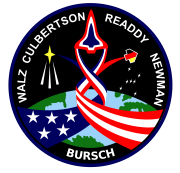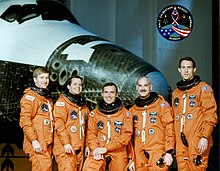Advanced Communications Technology Satellite

Discovery in orbit, seen from the SPAS astronomy platform
|
|||||
| Mission type | Satellite deployment Astronomy |
||||
|---|---|---|---|---|---|
| Operator | NASA | ||||
| COSPAR ID | 1993-058A | ||||
| SATCAT № | 22795 | ||||
| Mission duration | 9 days, 20 hours, 11 minutes, 11 seconds | ||||
| Distance travelled | 6,608,628 kilometers (4,106,411 mi) | ||||
| Orbits completed | 157 | ||||
| Spacecraft properties | |||||
| Spacecraft | Space Shuttle Discovery | ||||
| Landing mass | 92,371 kilograms (203,643 lb) | ||||
| Payload mass | 18,947 kilograms (41,771 lb) | ||||
| Crew | |||||
| Crew size | 5 | ||||
| Members |
Frank L. Culbertson, Jr. William F. Readdy James H. Newman Daniel W. Bursch Carl E. Walz |
||||
| Start of mission | |||||
| Launch date | 12 September 1993, 11:45 UTC | ||||
| Launch site | Kennedy LC-39B | ||||
| End of mission | |||||
| Landing date | 22 September 1993, 07:56 UTC | ||||
| Landing site | Kennedy SLF Runway 15 | ||||
| Orbital parameters | |||||
| Reference system | Geocentric | ||||
| Regime | Low Earth | ||||
| Perigee | 300 kilometres (190 mi) | ||||
| Apogee | 308 kilometres (191 mi) | ||||
| Inclination | 28.45 degrees | ||||
| Period | 90.6 min | ||||
|
|
|||||


Left to right: Culbertson, Bursch, Walz, Readdy, Newman
STS-51 was a Space Shuttle Discovery mission that launched the Advanced Communications Technology Satellite (ACTS) in September 1993. The flight also featured the deployment and retrieval of the SPAS-ORFEUS satellite and its IMAX camera, which captured spectacular footage of Discovery in space. A spacewalk was also performed during the mission to evaluate tools and techniques for the STS-61 Hubble Space Telescope servicing mission later that year. STS-51 was the first shuttle mission to fly a GPS receiver, a Trimble TANS Quadrex. It was mounted in an overhead window where limited field of view and signal attenuation from the glass severely impacted receiver performance. (Full triple-redundant 3-string GPS would not happen until 14 years later with STS-118.)
STS-51 was notable for having been scrubbed three times on the launchpad, each time after the crew had boarded the spacecraft:
The Advanced Communications Technology Satellite was deployed on flight day 1. This satellite served as a test bed for advanced experimental communications satellite concepts and technology. Its Transfer Orbit Stage (TOS) upper stage fired on time 45 minutes after deployment and boosted the satellite to geosynchronous altitude on the first day of the mission.
...
Wikipedia
